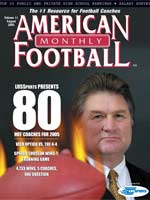AMERICAN FOOTBALL MONTHLY THE #1 RESOURCE FOR FOOTBALL COACHES
Article CategoriesAFM Magazine
|
LRSSports presents 80 Hot coaches for 2005© More from this issueMany coaches – from the NFL to high school – are ready for a break-out season. But will it be a sizzle or fizzle? So often expectations don’t match performance. This year American Football Monthly again looks at the falls ‘hot’ coaches. This year’s listing includes those primed for success like James Madison’s head man Mickey Matthews (left). Division I-A Gregg Brandon, Bowling Green: When Urban Meyer made his college head coaching debut at Bowling Green and won 17 games in two seasons, he turned that success into coaching stints at Utah and Florida. Now that Brandon has gone 20-6 and led the Falcons to back-to-back bowl wins for just the second time in school history in his first two seasons as a college head coach, don’t be surprised if major college administrators take notice. B....The full article can only be seen by subscribers. Subscribe today!
|
|
|||||||
| HOME |
MAGAZINE |
SUBSCRIBE | ONLINE COLUMNISTS | COACHING VIDEOS |
Copyright 2025, AmericanFootballMonthly.com
All Rights Reserved





